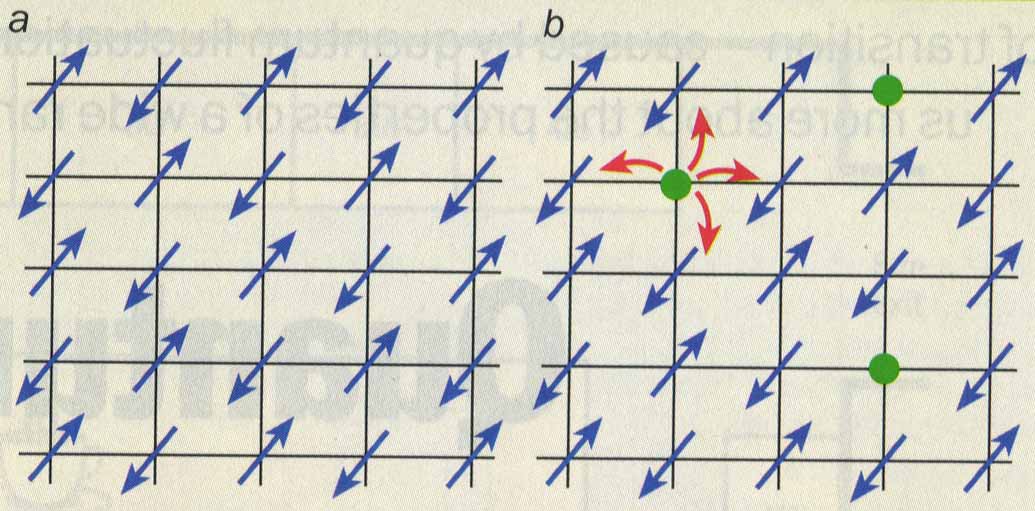
(b) The addition of strontium ions has the effect of introducing "holes" into the spin lattice. These holes can hop between lattice sites, as indicated by the red arrows.
In 1986, Georg Bednorz and Alexander Müller of IBM Research in Zurich discovered that a class of ceramic compounds was able to conduct electricity without resistance - i.e., they were superconducting. These materials consisted of two-dimensional layers of copper oxide with lanthanum and strontium ions in between. The particular compound studied by Bednorz and Müller, La1.85 Sr0.15 CuO4, had a superconducting transition temperature of 30 K, which was significantly higher than any other superconductor at the time - hence the name high-temperature superconductivity.
Since then, other copper oxides with transition temperatures as high as 130 K have been discovered and a vast number of experimental techniques have been used to probe their physical properties. These include measurements of a quantum phase transition at which the magnetic order vanishes. The insight gained from the understanding of the magnetic quantum critical point should have significant implications for the superconductivity itself, which is still not fully understood, although that is beyond the scope of this article.
First, let us consider one of the parent compounds of the cuprate superconductors: La2 CuO4 is an insulator, and its important low-energy excitations consist primarily of spin fluctuations on the copper ions, which have a charge of +2. These ions are stacked in layers, with the copper ions placed on the vertices of a square lattice. The coupling between adjacent layers is quite small, so we can consider the properties of a single two-dimensional layer. Each copper ion has a single unpaired electron, and has total spin S = 1/2. The interactions between the electrons are antiferromagnet: that is, that neighbouring spins tend to point in opposite directions.
|
Figure 2: Magnetic interactions in a superconductor
|
|
 |
|
|
(a) The lattice of copper ions in a single layer of La2 CuO4. Each ion has a free spin, and at zero temperature these spins exhibit antiferromagnetic order.
(b) The addition of strontium ions has the effect of introducing "holes" into the spin lattice. These holes can hop between lattice sites, as indicated by the red arrows. |
If the spins were classical objects, the ground state of the system would be quite simple: the spins would arrange themselves in a checkerboard pattern containing two sublattices: the spins would point "up" in one sublattice and "down" in the other (Fig 2a). The quantum mechanical system is considerably more complicated, but it is now well established that its ground state is qualitatively similar to that of the classical model. However, the average magnetic moment on each site has been reduced from S = 1/2 by quantum fluctuations. The low-lying excitations above this ground state consist of "spin waves". These are slow variations in the orientation of the local direction of the antiferromagnetic order. This combination of an S = 1/2 antiferromagnetic ground state and spin-wave excitations is found in several systems that undergo quantum phase transitions.
At any non-zero temperature, a large number of these low energy spin-waves are excited. The resulting thermal state has two crucial properties: (a) it allows the system to be described in terms of quasi-classical waves; (b) the nonlinear interactions between the spin-waves are particularly strong in two dimensions, leading to large fluctuations in the local orientation of the antiferromagnetic order, and hence the destruction of any long-range order.
So far we have only considered thermal fluctuations. To access a quantum critical point we must remain at T = 0 and vary a material parameter. The most common choice is to replace the lanthanum ions with another metallic ion such as strontium to form La2-x Srx Cu O4. Superconductivity appears at x » 5%, but we are interested in the quantum phase transition in the magnetic order that takes place at x = 12%.
The strontium ion has one fewer electron than lanthanum to donate to the copper oxide layers, so the effect of doping is to introduce "holes" into the square lattice antiferromagnet. These holes can move through the lattice by a quantum hopping process (Fig 2b). The physics of such a "diluted" quantum antiferromagnet is incredibly rich.
A number of recent neutron scattering experiments, especially those performed by John Tranquada and co-workers at the Brookhaven National Laboratory in the US, have provided crucial new understanding of the properties of diluted antiferromagnets. Experiments have shown that the holes like to concentrate in "stripes" in the material that are a few lattice spacings wide and about the same distance apart. Moreover, they tend to move only along these stripes (Fig 3a). Interspersed between these "hole-rich" stripes are regions of undoped, insulating antiferromagnet Aspects of this stripe formation were in fact predicted theoretically in 1989 by Jan Zaanen of the Lorentz Institute in Leiden and Olle Gunnarsson of the Max Planck Institute in Stuttgart, and also by the late Heinz Schulz of the University of Paris-Sud in Orsay.